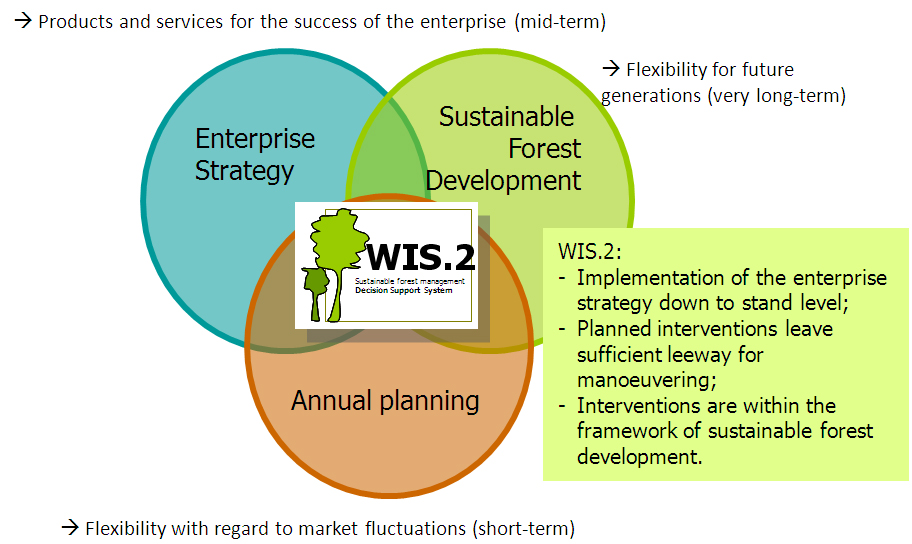WIS.2
Brief Overview
WIS.2 is a decision support system for monitoring and ensuring the sustainable, goal-oriented and efficient management of forest ecosystems, especially with regard to the:
- integral handling of significant spatial- and temporal scales in forest ecosystems (i.e., multiscalarity, sustainability);
- valorisation of intrinsic multiple ways of using the forest (i.e., multifunctionality, adaptability);
- implementation of a liberal and pragmatic view of silviculture as applied in Switzerland (i.e., flexibility, close-to-nature).
WIS.2, based on MS Access and ArcGIS ArcView, is composed of different applications, each handling a main aspect of the management of forest ecosystems. This prototype is currently being tested in three forest enterprises and is also being promoted by a forest engineering firm. WIS.2 is used at all levels of education for forest management in Switzerland.
WIS.2 was initially developed within the framework of a PhD thesis during 2001-2005, and has since then been successively developed in an iterative manner using inputs gained from practical experience. Plans are currently being made to refine the tool in a research and development project and launch a commercial product called SMART-Forest.
Scope of the System
WIS.2 focuses on providing guidance in sustainable forestry management. The system gives strong organisational and decision support in implementing and monitoring silvicultural practices. The system provides specific information for the different phases of the silvicultural process, allowing planners to simulate the mid- to long-term consequences of various action scenarios, and supporting users in solving complex silvicultural problems at multiple scales (i.e., from the whole enterprise level down to the single stand level; from short-term to very long-term). The scope of WIS.2 covers:
- defining different variations of silvicultural strategy and implementation concepts, in order to assess the engineering strategy and recognize the mid to long-term consequences;
- formalising the manifold demands of society, forest owners and stakeholders for implementation in forest management;
- pointing out the priority-of-action by connecting long-term strategic planning with mid-term harvesting planning;
- systematically documenting and reporting the decisions taken with regard to the managerial plan;
- facilitating regular control of the development of forest areas with regard to the realisation of the enterprise strategy;
- giving guidance on how to react in a flexible way to changes such as market fluctuations and unforeseen events like storms;
- enabling the user to handle the given complexity - step by step.
System Origin
As multi-purpose, near-to-nature silviculture seeks to steer forest dynamics towards socio-economic and conservation goals through minimal anthropogenic intervention, the necessity for a powerful forest management decision support system that implements and monitors such silvicultural practices is getting stronger. In order to face this challenge, WIS.1 was initially designed in the 1990s by Good and Pistor (1992<Good, E., Pistor, T., (1992): Waldbauliches Informationssystem WIS, Handbuch. Professur für Waldbau, ETH Zürich, Zürich>) as an information system for silvicultural planning at stand level. The system was further developed as WIS.2 by Rosset (2005 ) within the framework of his PhD thesis during 2001-2005 at the Swiss Federal Institute of Technology in Zurich, Switzerland (ETHZ). During this phase, the information system evolved from an information system to a DSS by integrating knowledge and supporting the entire decision process of the management of forest ecosystems. Over the past few years, further adaptations have been subsequently made, such as e.g. during a 10-days course on silvicultural planning held at the ETHZ in a small forest enterprise (150ha) owned by the Canton of Zurich.
WIS.2 has real-life application scenarios on the level of forest management, education, as well as in research and development.
Forest management
In forest management the tool has been extensively applied in the:
- State forest of Teufen in Canton Zurich (i.e., the 10 day course);
- teaching and research forest of the ETH in Zurich;
- forest of the city of Winterthur[1];
- forest of the city of Rheinfelden[2];
- forest of the village of Bullet in Canton Vaud (diploma thesis);
Plans are currently being made to apply the tool in a forest in Canton Freiburg, as well as in a forest in Thailand (diploma thesis).
Education
WIS.2 is being applied at all levels of the education in forest management in Switzerland in order to illustrate and demonstrate forest planning.
The main motivation behind introducing WIS.2 in teaching is to:
- enhance awareness of the consequences of very slow tree growth by visualising long-term trends resulting from decisions taken (i.e., the necessity to ensure certain continuity);
- concentrate on concept building to derive urgency of intervention to be undertaken at stand level (i.e., how to steer forest dynamics in order to reach the production target as efficiently as possible) and subsequently visit each individual stand separately;
- elaborate on and compare different variations in forestry management.
Students who have used the prototype have been providing valuable feedback that is in an iterative manner to improve the IT-solution. Research and development: a further tool based on the same platform (WVK) is currently being developed [3].
Research and Development
WIS.2 is not yet a commercial product, however, a proposal is currently being written in order to be able to refine the system within the framework of a research project and launch a commercial product through industrial partnerships under the name of SMART-Forest.
